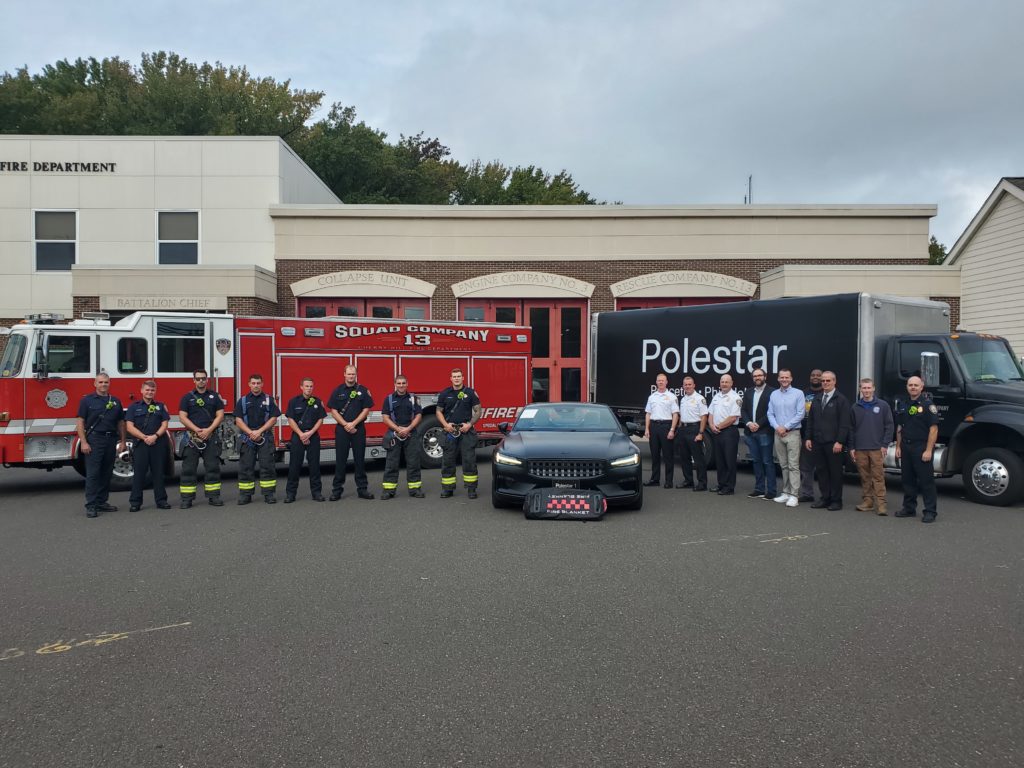
On Friday, Oct. 6, the Princeton and Philadelphia branch of Polestar, a Swedish electric vehicle manufacturer, donated a one-time use electric vehicle fire blanket made by All Hands Public Safety to the Cherry Hill Fire Department to help put out electric vehicle fires.
The Cherry Hill Fire Department was one of 12 departments to receive a blanket as part of Polestar’s program . Other departments included Princeton Township, Quaker Township, Raritan, Upper Marion Pennsylvania and several other areas near Princeton and Philadelphia.
“We started an initiative about a year ago on helping first responders and fire departments with fire blankets for electric vehicles and here we are at our fourth donation at the Cherry Hill Fire Station,” said Nicholas Long, Represent Polestar Philaedelphia and Polestar Princeton.
One blanket is around 20 by 26 feet and weighs close to 60 pounds. Sales Manager for All Hands Public Safety Joe Adams noted that one blanket is big enough to cover a small SUV and small cars, but two blankets may be needed for something larger, like a pickup truck. One single-use car fire blanket costs $1,289.99, and a reusable car fire blanket costs $3,289.99 according to the All Hands Public Safety website.
The purpose of the blanket is to help suffocate the fire by depriving it from oxygen and contain the fire so it doesn’t spread, which is helpful for putting out fires in parking garages, road tunnels, car ferries and car repair shops.
“The blanket is a whole new concept and it’s something we’re actually watching,” said Cherry Hill Fire Chief Wade Houlihan. “We’re doing our best to be progressive in fire services in general, constantly trying to stay ahead of the curb with some of these firefighting techniques. This is just something that has come along recently.”
According to the fire chief, motor vehicle fires occur fairly regularly. In the past year, the fire department has been dispatched around 100 to 150 times for motor vehicles overheating or that may be on fire but counted 30 to 40 that were actual car fires. Though there was no clear breakdown of gas to electric vehicles, the chief noted that electric vehicle fires were more rare and much less common than fires caused by gas-vehicles.
Tim McGeady, Assistant Chief for the Cherry Hill Fire Department, explained some of the challenges they face when putting out electric vehicle fires.
“The fuel source in a standard internal combustion engine would be gasoline or diesel, fuel, but for electric vehicles, the fuel source that most typically are the batteries themselves,” explained McGeady. “That poses a unique challenge to extinguishing electric vehicle fire.”
McGeady shared that many times, the batteries are located under the driver and passenger seat between the axles of the care and are usually in a protective steel enclosure to limit damage if it’s involved in an accident.
“By virtue of that, it makes it difficult for us to apply water directly to the batteries,” McGeady said. “The goal in an electric vehicle fire is for us to try and cool the batteries down, because that’s a chemical reaction fueling the fire. … It becomes problematic for us because they can potentially burn for a very long time.
“It’s basically a runaway chemical reaction and the only way of stopping it is by cooling it, and the construction of the vehicle by protecting the batteries, makes it difficult to do.”
Houlihan also noted that the fire truck unit on scene was a hazardous response unit, as batteries are considered hazardous materials. This means that the firefighters assigned to this unit are specialists in hazardous materials response.
“It’s always nice when we have a good partnership with some of the manufacturers, the sales team and things like that,” said Houlihan. “And the fact that they donated it, we’re super thankful for that.”
If one is ever in need of assistance for a motor vehicle fire, the fire chief recommends calling 911, where a central dispatcher can connect the appropriate teams.


